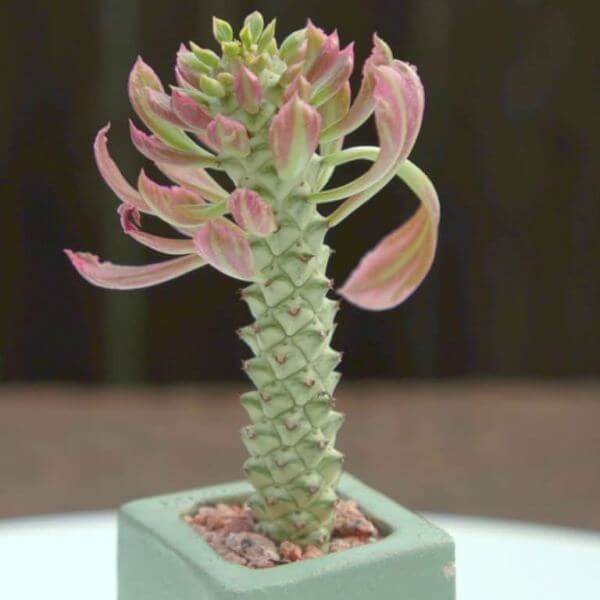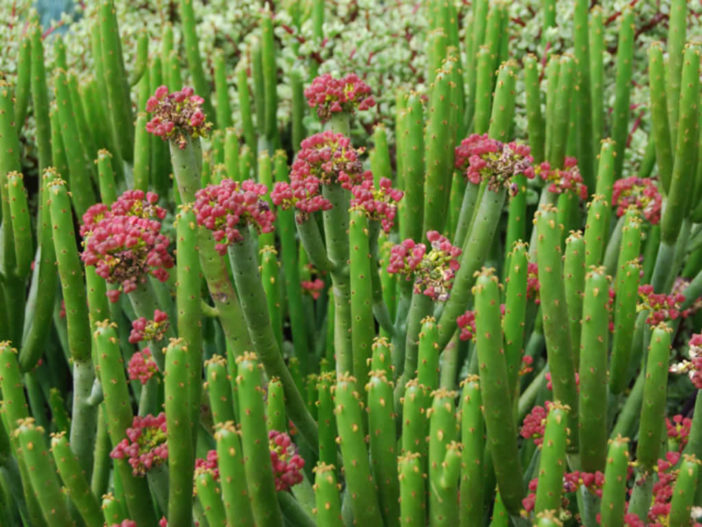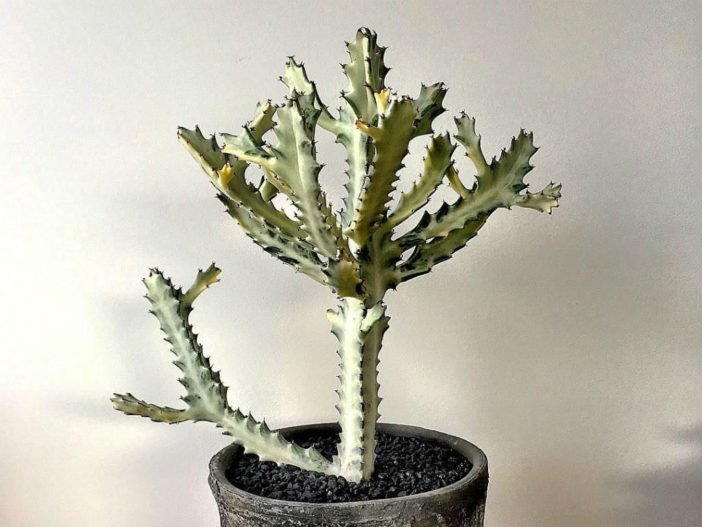All plants (and succulents, in particular) are known for adjusting to and overcoming the harsh climates and predators where many humans just cannot. I was reminded of this the other day when I pricked myself good on a particularly spiny succulent plant which got me thinking, are some of my favorite plants poisonous or do they just want to stab me?
The majority of succulents are not at all poisonous to humans. Many are used in very common medicines and ointments, some for centuries. However, several are poisonous to humans. Several euphorbias, in particular, are known to be toxic when touched or ingested, so take care when handling them.
A note before reading further. This article is in no way intended to replace orders or directives from a physician or healthcare professional.
If you are having any adverse side effects at all from ingesting any plant matter spoken about in this article (or any other plants or allergens for that matter), please contact your physician, poison control, or 911 immediately.
Dangerous succulents vs. poisonous succulents
Any succulent with any spines at all should be handled with care. This goes double for you if you have pets or children around.
Be mindful to plant them away from your loved ones and read on for some basic tips on how to keep everyone who may be exposed safe.
That said, most succulents are not poisonous to humans save a few from the Euphorbias family.
These have been known to be toxic to humans for a long time now.
Euphorbias
There is some discrepancy about whether Euphorbias are actually a succulent or not, but one thing’s for sure, you should take great care in handling this particular species.
It is always advisable to wear gloves when handling Euphorbias.
Euphorbias are in the spurge family. The name is derived from the French word espurgier which means “to purge.”
Euphorbias secrete a milky substance known to cause rashes when it comes in contact with the skin. If ingested, euphorbias are known to cause blistering of the mouth and if enough is ingested people been known to vomit.
The secretion of the euphorbias is also known as latex.
A little history about Euphorbias; for centuries they’ve made Euphorbia seeds into medicine.
It’s been used as a laxative for a long time, but it’s also been used to treat intestinal parasites, tumors, and even warts.
(Found via https://www.sciencedirect.com/topics/agricultural-and-biological-sciences/euphorbia)
Here are some common euphorbias to be aware of.
Euphorbia Marginata (Snow on the Mountain)

Many plants in the Euphorbia family are borderline succulents at best, but one thing everyone agrees on is that great care needs to be taken when handling them. This is very true for Euphorbia Marginata, a.k.a. Snow On The Mountain.
This particular species needs lots of sunlight and grows from southwest Canada down to the Southwest United States.
It grows up to 3 feet tall and blooms from July until September. It lives through about anything, including drought and heavily polluted areas.
It doesn’t much care what kind of soil it grows in so long as it drains well.
Euphorbia Lugardiae

Euphorbia Lugardiae is a succulent native to South Africa, Mozambique, Zimbabwe, Botswana, and Swaziland. It does fantastic in full light, but if you pot it in some light shade, it will be just fine.
Some side effects from ingesting its latex can include cirrhosis of the liver, gastroenteritis and internal hemorrhaging, and vomiting. Medicine men of prepared and eaten the root because of its hallucinogenic properties.
It grows best in very sandy soil along outcrops of granite.
It can grow about 2 feet tall, and its stem can grow to be just over an inch wide.
Like with all other euphorbias on this list, take care to use gloves when handling this plant.
Succulent aficionados will appreciate the rarity of this plant in the United States. Not many people keep them but those that do cherish them.
Euphorbia Succulenta

Originally native to Kenya, Tanzania, and Uganda, Euphorbia Succulenta can also be grown in the Southwest United States effectively.
This Euphorbia variety looks like a little angry octopus.
It’s green tentacles; I mean stems (or tubercles) can grow up to 2 feet long and will bloom white or pink flowers.
Euphorbia Cotinifolia (Caribbean Copper Plant)

The Caribbean Copper plan is native to Mexico and South America but grows very well in southern Arizona, New Mexico, and California as well.
This ornate shrub produces deep purple/red leaves in the shape of an oval that grows up to 3 inches wide and 4 inches long. It blooms tiny white flowers that look very pretty against the reddish-purple leaves.
I’ve seen Japanese Maples of a very similar color, and this shrub can complement the yard’s greenery very well.
Not only does the shrub have a very unique color, but it also grows very large as well. On the smaller side, it will grow to about 9 feet, while larger ones grow to up to 18 feet tall.
So long as it doesn’t get below 20°F in your region, this is a great plant to have outdoors.
Like every other Euphorbia on this list, always wear gloves when handling the Caribbean Copper plant.
Euphorbia Cylindrifolia

The Euphorbia Cylindrifolia is an endangered plant native to Madagascar.
It is indigenous to the Fort-Dauphin in the Southeast region of the island, and its natural habitat is less than 19,000 ac.²
Deforestation of its natural subtropical and tropical dry forests and shrubland mean to threaten the future of this plant.
It needs a bit of shade throughout the day, so it grows inside thorny bushes, aloe plants, and other euphorbias species to give it a break from the hot sun.
Euphorbia Alluaudii (Cat Tails Euphorbia)

Another native to Madagascar.
Unless preservation efforts start ramping up big time, it will see the same fate as the Euphorbia Cylindrifolia.
Its habitat is much larger than that of the Euphorbia Cylindrifolia, and it does grow better in hilly, rocky regions, so it isn’t quite as endangered as the Euphorbia cylindrifolia, but it is on the endangered list.
This is another spineless succulent shrub that grows very tall, commonly from 8 to 12 feet tall. It does a great growing at altitudes under 1000 feet with minimal humidity.
Euphorbia Enopla (Pincushion Euphorbia)

The pincushion Euphorbia has its name for an excellent reason. It’s entirely covered with red spines that grow to over half an inch long that frankly look very beautiful, yet intimidating.
The spines protrude from small areoles that lined the ribbed stem. In this way, it looks like many common cacti that inhabit arid regions throughout the continental United States.
Plants produce either male or female flowers (also known as cyathium or cyathia). The female flowers are dark red, while the male flowers are yellow.
This plan is native to South Africa but grows great anywhere arid that doesn’t get below 25°F extended periods of time.
Euphorbia Lactea or ‘White Ghost’ (White Ghost Candelabra Spurge)

Euphorbia Lactea is one of the more unique euphorbias in the list.
It’s native to India but grows well outdoors here in the United States so long as the temperature never drops below 30 to 35°F.
This plan is a little more fickle than most other succulents. It’s essential that it stays in the partial shade. Too much sunlight causes it to burn, and when you have something this beautiful you want to work to keep it healthy!
When you water the White Ghost, be sure you pour water directly on the stem and let it trickle down. The small spines will place the water correctly over the root system for maximum absorption.
You can read more about this succulent adaptation here.
Euphorbia Decaryi
Yet another Euphorbia from Madagascar (yes, the trend your spotting is real). This little guy grows to about 6 inches tall and has some of the most exciting leaves I’ve seen.
The leaves grow about an inch and a half long and up to just under half an inch wide. The edges of the leaf crinkle up and fold, like the edges of a lasagna noodle.
I like the dark green in these leaves, especially with the contrasting brown stalk.
The flowers bloom in a shade of yellow or red.
Euphorbia Mammillaris (Corn Cob Euphorbia)
The corn cob Euphorbia is native to South Africa and looks like several other varieties of cacti that you have undoubtedly seen before.
It grows to about 7 inches tall and is covered in gray spines.
It has ridges to allow the core to expand in the rainy season and contract as it utilizes moisture during times of drought.
It’s also known as an Indian corncob, but I prefer corncob Euphorbia.
This deep green succulent is perfect if you are looking for large clusters of thick stems. The pinkish/reddish spines grow up to half an inch long and are present mostly on the tips of the stems, though you’ll find strays up and down the ribbed cores of the plant from time to time.
A single, yellow flower bloom on the tip of the stems each year from early spring to early summer.
Euphorbia Tithymaloides ‘Variegatus’ – Variegated Devil’s Backbone

If the title of this plant didn’t get your attention, I have no idea what will.
Perhaps the pink bloom like seed pods that appear every spring will. 🙂
This plant likes humidity.
It is native to tropical and subtropical North and Central America, grows up to 8 feet tall and 2 feet wide, and like all other euphorbias should be handled with gloves.
Euphorbia Milii var. roseana (Crown of Thorns)

The Crown of Thorns is a favorite of outdoor succulent enthusiasts for good reason. It is resistant to drought, deer, rabbits, salty air and soil, and almost every other pastor disease you can think of.
Also, it flowers from about early March all the way into early winter. This is very abnormal for succulents but makes it a great looking plant for your yard or indoor garden.
It grows from 3 to 6 feet tall and spreads out 1 to 3 feet wide.
It is said that the crown of thorns depicted on the head of Jesus during his crucifixion was made from the stems of this plant, hence its common nomenclature.
A fantastic resource for more information on the Euphorbia family can be found at https://worldofsucculents.com .
Succulent Plant Safety
Although most succulents are not poisonous to humans, particular care should be taken for several varieties. In particular, we should be mindful of small children or animals that you would like to keep safe.
Here are some tips to help keep your plants and your loved ones safe.
- If you have pets or children, plant your euphorbias and spiny succulents where they can’t get to them if you keep them indoors. The higher the steady perch, the better.
- If you plant your euphorbias outside, keep them away from walkways, paths, and sidewalks.
- Plant them around companion plants if you’re able. This will act as a visual barrier.
- Put on a long sleeve shirt and long pants along with gloves, especially if you have sensitive skin. Even accidentally grazing some of these plants can cause skin irritation.
- Wash your hands immediately after you handle them, even if you have gloves on.
- Never touch your eyes or your mouth with unwashed hands. They can severely burn your eyes, and if the milky substance gets in your mouth, it’s possible to cause rashes or even vomiting if enough of the substance is ingested.
- Wrap a succulent in a towel or newspaper before you try to handle them. They may not be poison, but they can be a pain!
- If you have a concern that you’ve been poisoned, call poison control right away to see what you should do and if you feel that you are in need of emergency health care, call 911.
Succulent Pet Safety
Are succulents safe to be around your pet?
Most succulents are, but there are several that you should be mindful of if you own a dog, cat, bird, or horse.
There are several different succulent varieties to be kept away from your animals, and we’ll talk about those if you check out the article “Are Succulents Poisonous To Cats?” here.
So in short, most succulents are entirely safe for humans. Several are even edible.
Thanks for reading and please share with friends below 🙂
